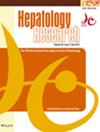The new assay type IV collagen 7S (CLEIA) is a useful test to identify progressive fibrosis in chronic liver disease: A study based on magnetic resonance elastography
Abstract
Aim
Liver fibrosis is a critical prognostic factor for chronic liver disease that influences morbidity and mortality. Type IV collagen 7S, measured using a chemiluminescent enzyme immunoassay, was evaluated as a novel noninvasive biomarker with its cutoff value determined via magnetic resonance elastography (MRE) to eliminate sampling bias. A two-step approach combining the fibrosis-4 (FIB-4) index and type IV collagen 7S demonstrated potential in enhancing risk stratification and clinical utility.
Methods
This study included 307 patients with chronic liver disease and 235 with metabolic dysfunction-associated steatotic liver disease. Type IV collagen 7S was compared with biomarkers such as FIB-4 index, M2BPGi, and hyaluronic acid. Diagnostic accuracy was assessed using AUROC, sensitivity, specificity, positive predictive value (PPV), and negative predictive value, with cutoffs determined via the Youden Index. Subgroup analyses evaluated performance based on ALT levels (≤30 and >30 U/L) and age (≤60 and >60 years). A two-step risk stratification model incorporating type IV collagen 7S was developed for intermediate FIB-4 index groups (1.3–2.66) to assess its utility.
Results
For liver stiffness assessed using MRE, type IV collagen 7S showed the highest correlation (ρ = 0.591, p < 0.001) and outperformed other biomarkers, particularly for F ≥ 2. Its performance was notable in patients with low ALT levels (≤30 U/L) and in elderly patients (>60 years). In the intermediate FIB-4 index group, the two-stage model reduced over triage by 20%, increased specificity from 55% to 78% and enhanced PPV by 13%.
Conclusions
The novel assay, type IV collagen 7S, is a highly effective and noninvasive biomarker for liver fibrosis. The performance of type IV collagen 7S tends to have robustness under the difference of ALT. Its combination with the FIB-4 index enhances diagnostic precision, particularly in intermediate-risk patients, reinforcing its role in refining fibrosis staging and optimizing patient management.


 求助内容:
求助内容: 应助结果提醒方式:
应助结果提醒方式:


